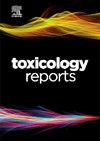体外分析电子烟液及其蒸气对人肺上皮细胞(A549)的急性毒性
Q1 Environmental Science
引用次数: 0
摘要
在过去5年里,电子烟等替代烟草产品的使用显著增加,其中18 - 25岁人群的增幅最大。虽然尼古丁的含量受到严格管制,但电子液体调味料的成分在很大程度上是不受监管的,而且往往没有出现在产品标签上。在此,我们比较了载体液体丙二醇(PG)和amp;植物甘油(VG)与五种流行的风味浓缩物:薄荷醇、樱桃、奶油糖果、香草波旁威士忌和烟草对人类肺泡II型细胞样A549细胞的影响。以液体和蒸汽两种形式对调味料进行了测试,并开发了一种蒸汽试验来评估调味料的细胞毒性。我们的研究结果表明,薄荷醇液体是最具细胞毒性的(LD50 = <;0.5 % /暴露<;4 h)。其次是樱桃和香草波旁威士忌,在8 小时的暴露中产生了4 %的类似反应。烟草在24 小时暴露浓度为>; 4 %时毒性仅达到50% %。奶油糖显示出与PG和VG相似的毒性特征,在8 %浓度下,所有时间点的细胞毒性都超过20 %。作为蒸汽,薄荷醇的细胞毒性被进一步评估,活细胞显著减少,坏死细胞数量增加5倍,在5次雾化后,只有11. %的细胞仍然存活。分析显示,液体中存在有毒化学物质和重金属,因此需要进一步研究,以充分阐明长期使用电子烟设备的调味剂及其可能对人体肺部健康的影响。本文章由计算机程序翻译,如有差异,请以英文原文为准。
Analysing the acute toxicity of e-cigarette liquids and their vapour on human lung epithelial (A549) cells in vitro
The use of alternative tobacco products such as vaping devices has significantly increased over the last 5-years, with the largest increase being amongst 18–25-year-olds. While the quantity of nicotine is tightly regulated, the composition of e-liquid flavourings is largely unregulated, and often absent from product labels. Herein, we compare the toxicity of carrier liquids propylene glycol (PG) & vegetable glycerine (VG) with five popular flavour concentrates: menthol, cherry, butterscotch, vanilla bourbon and tobacco on human alveolar type II cell-like A549 cells. The flavourings were tested in both liquid and vapour form and a vapour assay was developed to assess cytotoxicity of the flavourings. Our results conclude that menthol liquid was the most cytotoxic (LD50 = <0.5 % over a <4 h exposure). Followed by cherry and vanilla bourbon which elicited a similar response at 4 % over 8 h exposure. Tobacco only reached 50 % toxicity at a concentration > 4 % over 24 h exposure. Butterscotch displayed similar toxicity profiles to PG and VG where cytotoxicity exceeded 20 % at 8 % concentration at all time points. The cytotoxicity of menthol was further evaluated as a vapour, with a significant reduction in viable cells and a 5-fold increase in the number of necrotic cells with only 11 % of cells remaining viable after 5 vaping episodes. Analysis revealed the presence of toxic chemicals and heavy metals in the fluids therefore further research is required to fully elucidate the long-term usage of flavourings with vaping devices and the impact this may have on human lung health.
求助全文
通过发布文献求助,成功后即可免费获取论文全文。
去求助
来源期刊

Toxicology Reports
Environmental Science-Health, Toxicology and Mutagenesis
CiteScore
7.60
自引率
0.00%
发文量
228
审稿时长
11 weeks
 求助内容:
求助内容: 应助结果提醒方式:
应助结果提醒方式:


